The Hague, The Netherlands, April 2012
The Louwman Museum
The Dutch National Museum
To go directly to our photos from the Louwman Museum, click here.
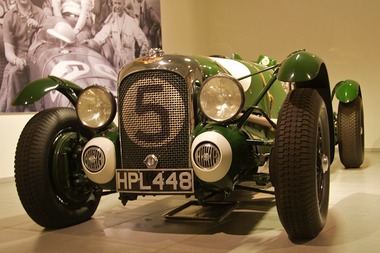
This is a fantastic place combining wonderful display areas with the finest, most varied collection of both restored and original automobiles I have yet seen. Add excellent printed materials in Dutch and English giving detailed histories of the cars on display and you really have something. Add again an amazing collection of photographs blown up and displayed with the cars; not just any photos, but actual pictures of this individual car either in races or with its original owners and the overall effect is stunning. For these reasons I feel that this museum deserves its own information page so that I can share some of its details with you.
We’ve been to many museums where every car is restored to better than new condition; the Nethercutt in California is a fine example and the cars are beautiful. We’ve also been to interesting museums where the cars are in varying states of either restored or unrestored condition, often because the museum lacks the funding to complete the restorations. The Mahy collection in Belgium would be representative of this manner of presentation. The Louwman is the first we’ve seen where for reasons other than funding, significant portions of the collection have been left not just unrestored per se, but in documented original condition. The results are astounding. Now, most of the cars on display are indeed restored and they are beautiful. However, scattered throughout the museum are cars with amazingly detailed explanations of their history that are left unrestored simply because they are pure examples of vehicles as they left the factory many decades before. These cars are not damaged or rusted or in need of anything; they are simply and understatedly original. There are also examples of significant cars that have not just been restored to an as new appearance, they have literally been reconnected with parts that had been removed at various times in their past in order to be re-constructed back into the original vehicle as it left the factory. Again, the printed documentation provided and the attention to detail displayed by this museum is simply amazing.
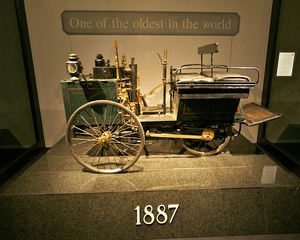
I regret that I did not gather specific information on as many cars as I should have. Suffice it to say that I was amazed and even awed by the histories presented in this museum. All is not lost however, as the museums excellent website provides all of this specific information for each car! Here are just a few examples of these historically significant cars.
There were several vehicles from the 1880s and 90s and the earliest years of the twentieth century in remarkable condition, but not restored. With original upholstery and paint, showing normal wear and tear, but in complete and apparently operable condition. The individual histories of these cars listed previous owners and other details of the vehicles’ pasts. The earliest of these vehicles are displayed in sealed glass enclosures for preservation purposes. It was simply stunning to look on a vehicle that was up to 125 years old and still in original condition.
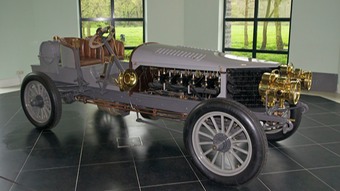
A Dutch manufacturer, Spyker, a make previously unknown to me, was understandably featured in this museum. The featured car scored firsts in a number of technical areas. It was the first six cylinder car in the world and also the first petrol driven car with both four wheel drive and four wheel brakes. The year was 1903. Allow me to quote from the text: “After being restored incompetently in the early 1920s, and following the bankruptcy of the company, the Spyker was bought by a former director. From 1953 to 1993 the car, which now had extensively modified bodywork, was housed in various Dutch museums, until it was acquired by the Louwman Museum. The car was restored over a five-year period to its original condition as displayed at Crystal Palace in 1904.”
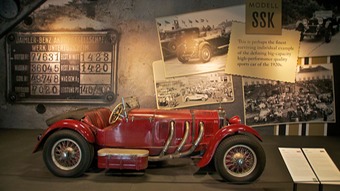
The quintessential sports car of the 1930s was the Mercedes SSK. We have been able to see a number of them over the years, including at the Mercedes Museum in Stuttgart, and they are always a treat to behold. The particular car on display at the Louwman is unrestored and its history is complete and amazing. The car has had only a few owners and photos appear of them with the car. This car, upon inspection after its acquisition by the museum was found to be amazingly intact. Only one part appeared to not be original as its serial numbers did not match the original factory documentation. An earlier owner had swapped the crankcase with another car during some repair. Amazingly, the museum discovered the paperwork as to which car now had this particular crankcase, tracked it down with the help of Mercedes, acquired the crankcase and reinstalled it in its original place.
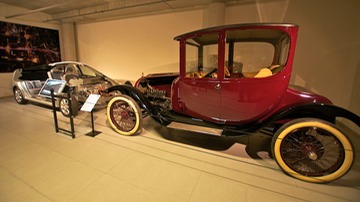
The museum has some fairly modern cars on display including a cutaway of a Toyota Prius Hybrid. Nothing too original there, but next to it is an earlier hybrid vehicle; from 1917. The Woods Dual Power, built in the USA, had a conventional gas engine plus an electric motor powered by a battery pack. The car could be operated on either one as selected by the driver. When the gas engine was running of course it would recharge the battery pack, and because of the electric motor, the engine did not need to be cranked to start, but enjoyed the luxury of electric start in an era when few cars did. Unfortunately for future generations, the factory shut down in 1918, just a year after the Dual Power was introduced.
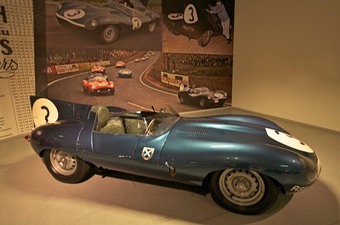
The history of the D-Type Jaguar is well known; the car, following the successful C-Type, helped Jaguar win the Le Mans 24 hour race five times in a six year period from 1952 to ‘57. The 1957 victory was particularly noteworthy as the factory had opted to not contest the race that year and left the job to five privately entered D-Types. The car on display at the Louwman won that race with a nine lap lead. It was followed by all four of its companions as Jaguar took 1st, 2nd, 3rd, 4th, and 6th places. After its Le Mans victory the car continued racing in private hands and, as such things happen, ended up being basically split in two to make two race cars when combined with other spare parts. To again quote from the display panel, “The Louwman Museum managed to acquire both cars, and following a lengthy and historically accurate restoration project, the original components were reunited.” Surely a classic example of understatement.
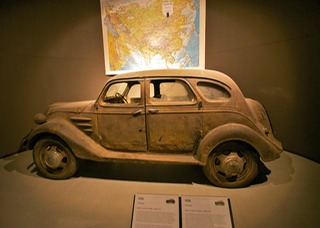
To close with perhaps the most astounding tale of all. The Louwman Museum has on display the only pre-war Toyota in the world; even Toyota does not have one. This car, made in 1936, was discovered fairly recently residing in Vladivostok where it had seemingly been since shortly after the war. The Louwman was able to arrange to purchase the car and it was then driven across Russia to the Ukraine where it could be loaded onto a car carrier for transport to Holland. Truly, truly an amazing story of dedication and respect for the value of historical truth. This car, not surprisingly, is displayed in completely unrestored, original condition.
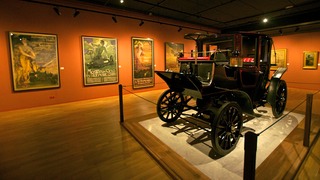
In addition to all the wonderful cars displayed, the tremendous information shared and the terrific use of photographs. The Louwman also displays a phenomenal collection of poster art taken from advertisements and auto show presentations during the classic period. These are displayed throughout the museum and particularly in a beautifully lit room resembling nothing more than something out of a fine art museum. Our photo page shares a sampling of photos of this wonderful art work although some of the best photos are in vertical format and cannot be properly shown here.
So, the Louwman is now our favorite car museum. The collection is superb and the presentation spares absolutely nothing to maximize the import of the information presented. The museum has only been opened in its current, and beautiful, setting since 2010 so everything is new and lovely. If you should find yourself anywhere near The Hague and have any interest in automotive history, do not miss an opportunity to see this museum.
To enjoy our photos from the Louwman Museum, click here.